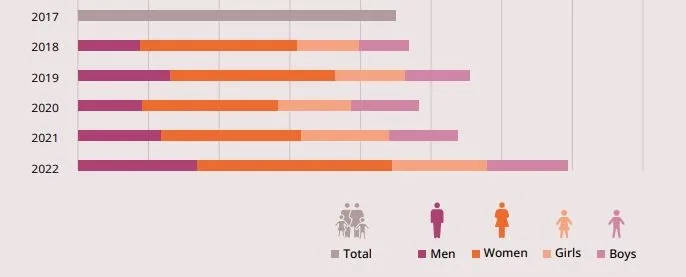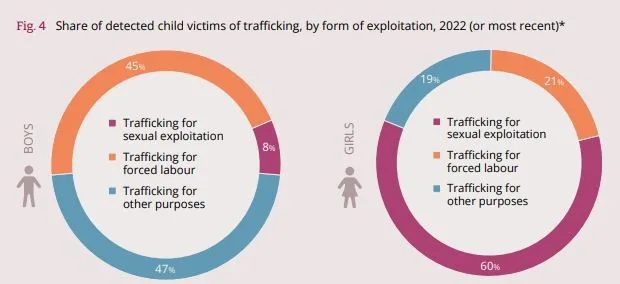Syllabus: GS2/Human Rights
Context
- The United Nations Office on Drugs and Crime has released its Global Report on Trafficking in Persons 2024.
About
- This is the eighth edition of the UN Report. First report was published in 2009.
- It covers 156 countries and provides an overview of the response to the trafficking in persons by analysing trafficking cases detected between 2019 and 2023.
Major Highlights
- A 25% rise in the global detection of victims was recorded in 2022 compared to 2019.

- Child Victims: In 2022, global detections increased 31% compared to the pre-pandemic levels in 2019, with a sharper increase of 38% specifically among girls.

- Majority of Victims: In 2022, 61% of trafficking victims detected worldwide were female.
- Adults continue to be the most detected age group, and adult females make up 39% of all detected victims.
- At the same time, girls make up a significant 22% of the total detected victims.
- Organised Crime Groups: 74% of the traffickers operated as groups and networks loosely connected in a business-type criminal relation or as structured criminal organizations.
- Non-organized criminals account for about 26% of traffickers convicted.
- Trafficking routes: Victims are trafficked globally through an increasing number of international routes, with African victims trafficked to the highest number of destinations.

| UN Office on Drugs and Crime (UNODC) – It is a global leader in the fight against illicit drugs and international crime, in addition to being responsible for implementing the United Nations lead programme on terrorism. – Established in 1997 and headquartered in Vienna. – UNODC relies on voluntary contributions, mainly from governments, to carry out the majority of our work. – The UNODC Strategy 2021-2025 is committed to promoting human rights, gender equality and disability inclusion, as well as protecting children and harnessing the transformative power of youth. |
Human Trafficking in India
- India recorded 10,659 cases of human trafficking between 2018 and 2022.
- Maharashtra registered the highest number of cases in the past five years, followed by Telangana and Andhra Pradesh.
- States like West Bengal and Assam are considered source States while Maharashtra and Karnataka are destination States.
Government Initiatives
- The Immoral Traffic (Prevention) Act, 1956 (ITPA) is the premier legislation for prevention of trafficking for commercial sexual exploitation.
- Article 23 of the Constitution of India prohibits trafficking in human beings and ‘begar’ and other similar forms of forced labour.
- Criminal Law (amendment) Act 2013 provides for comprehensive measures to counter the menace of human trafficking including trafficking of children for exploitation in any form.
- Protection of Children from Sexual offences (POCSO) Act, 2012, is a special law to protect children from sexual abuse and exploitation.
- Section 143 to 146 of the Bharatiya Nyaya Sanhita (BNS), 2023 provides penal provisions for various forms of trafficking in persons, habitual dealing in slaves and unlawful compulsory labour.
- UN Convention: India has ratified the United Nations Convention on Transnational Organised Crime (UNCTOC) which has as one of its Protocols Prevention, Suppression and Punishment of Trafficking in Persons, particularly Women and Children.
- SAARC Convention: India has ratified the SAARC Convention on Preventing and Combating Trafficking in Women and Children for Prostitution.
- A Regional Task Force was constituted to implement the SAARC Convention.
Source: UN
Previous article
Union Cabinet Gives Approval for Bills on Simultaneous Polls (ONOE)
Next article
Disease X